

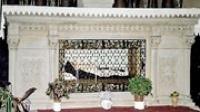
Relics of Bl Margherita in San Domenico
The Blessed Margherita (1287-1320), who is also known as “la Cieca della Metola” (blind woman of Metola), was born in la Metola. Her legend is known in two Latin versions, both of which probably date to the 14th century:
-
✴the so-called major version, which seems to have been written by a priest, perhaps a canon of San Florido; and
-
✴the so-called minor version, which seems to have been written by a Dominican friar.
Both versions seem to rely on an earlier version that was probably written soon after her death, presumably in the hope of her imminent canonisation. The Sienese Dominican Fr Tommaso Caffarini wrote an Italian version of this material in 1400.
According to these legends, the parents of the Blessed Margherita took her to San Francesco in ca. 1292, hoping that their prayers before the relics of the newly deceased Blessed James of Città di Castello would lead to a cure for her disabilities. When this failed, they abandoned her.
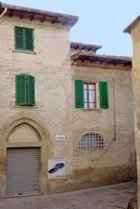
After her death, her body was taken there in procession to Santa Maria della Carità: apparently the friars had intended that she should be buried in their cloister, but the people insisted that she should be buried inside the church. Her body was embalmed at the expense of the city authorities. Three stones were found in her heart with images of Mary, Jesus and Joseph. Miracles were duly performed at her tomb.
The feast of the Blessed Margherita was documented in the city records in 1395. In 1422, the authorities promised an annual gift of wax, presumably for candles for the altar above her relics, which were then in the newly-completed church of San Domenico.
Cult of Blessed Margherita in the 16th and 17th centuries
The relics of the Blessed Margherita were transferred to a new coffin in 1588, at which point they were found to be perfectly preserved. Pope Paul V recognised the cult for the local Dominicans in 1609 and Pope Clement X extended the privilege to the whole Dominican Order in 1675. The relics were translated to the new high altar of San Domenico in 1678.
Gilded Wooden Coffin (1558)
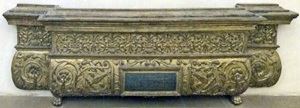
This coffin was commissioned to contain the relics in San Domenico after their recognition in 1588. The inscription reads:
DEIPARE VIRGINIS DEVOTISSIMA
VIRGO MARGHERITA TIFHER
PREDICATORUM GLORIA
HIC REQUIESCIT
The relics were removed from the coffin in 1678, when they were placed under the high altar of the church. It was documented in the church in 1728 but moved to the civic collection in ca. 1860. It is now in the Pinacoteca Comunale.
Scenes from the Life of Blessed Margherita (1662)
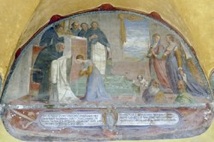
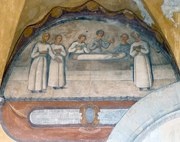
Fr. Lorenzo Giustini commissioned these frescoes os scenes from the life of the Blessed Margherita in the lower storey of the cloister of San Domenico. Each of the frescoes has a painted inscription describing the scene. Some of the scenes are now ruined and others have been heavily restored. The first five are by the aged Giovanni Battista Pacetti, lo Sguazzino. They include these two, which depict:
-
✴the Blessed Margherita receiving the Dominican habit; and
-
✴the funeral of the the Blessed Margherita.
After the death of lo Sguazzino, Salvi Castellucci painted the other 27 lunettes and the frescoes of Dominican saints:
-
✴the date 1662 appears in the inscription under the fresco in which the Blessed Margherita educates the children of Venturino (her adoptive father); and
-
✴the same date appears in two inscriptions that also contain the signature “SC”, under:
-
•Blessed Margherita cures the blindness of Sister Venturella; and
-
•the resurrection of Giustolo da Marzano.
Blessed Margherita of Città di Castello (17th century)

Read more:
G. Casagrande. “Margherita da Città di Castello”, Dizionario Biografico degli Italiani, 70 (2007) (and references therein)
M. Lungarotti, “Le Legendae di Margherita da Città di Castello”, (1994) Spoleto
Return to Saints of Città di Castello.

